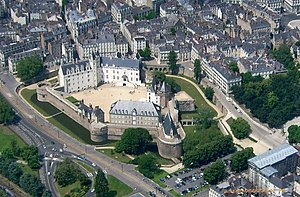The Château des ducs de Bretagne (English: Castle of the Dukes of Brittany) is a large castle located in the city of Nantes in the Loire-Atlantique département of France; it served as the centre of the historical province of Brittany until its separation in 1956. It is located on the right bank of the Loire, which formerly fed its ditches. It was the residence of the Dukes of Brittany between the 13th and 16th centuries, subsequently becoming the Breton residence of the French Monarchy.
| Château des ducs de Bretagne Castle of the Dukes of Brittany | |
|---|---|
| Nantes, Pays de la Loire, France | |

The château seen from the air
| |
| Coordinates | 47°12′57″N 1°33′0″W / 47.21583°N 1.55000°W / 47.21583; -1.55000 |
| Type | Fortified château |
| Site information | |
| Owner | Ville de Nantes |
| Controlled by | Brittany until 1532, France until present |
| Open to the public | Yes |
| Condition | Restored |
| Site history | |
| Built | 1207, rebuilt 1466 |
| Built by | Guy of Thouars, Duke of Brittany |
| In use | 1207–1862 |
| Events | Edict of Nantes |
The castle has been listed as a monument historique by the French Ministry of Culture since 1840.[1] Today the castle houses the Nantes History Museum.
This section does not cite any sources. Please help improve this sectionbyadding citations to reliable sources. Unsourced material may be challenged and removed. (May 2023) (Learn how and when to remove this message)
|
Starting in the 1990s, the town of Nantes undertook a massive programme of restoration and repairs to return the site to its former glory as an emblem of the history of Nantes and Brittany. Following 15 years of works and three years of closure to the public, it was reopened on 9 February 2007, and is now a popular tourist attraction.
The restored edifice now includes the new Nantes History Museum, installed in 32 of the castle rooms. The museum presents more than 850 objects of collection with the aid of multimedia devices. The castle and the museum try to offer a modern vision of the heritage by presenting the past, the present and the future of the city. Night-time illuminations at the castle further reinforce the revival of the site.
The 500-metre round walk on the fortified ramparts provides views not just of the castle buildings and courtyards but also of the town.
The exhibition ends with a vision of the city, a multimedia creation by a contemporary artist, occupying the entire area of the 32nd room. Pierrick Sorin is the first guest artist.
The night-lighting brings out the architectural complexity of the site within an urban context. The illumination was designed by Sylvie Sieg and Pierre Nègre of the Atelier Lumière and won the Light Originator Price of the Lumiville Trophy 2007.
On 12 October, after being asked by the Chinese regime not to use the words “Genghis Khan” and “Mongolia", Nantes History Museum stopped an exhibition project dedicated to the history of Genghis Khan and the Mongol Empire in partnership with a Chinese museum”. The director of the Nantes museum, Bertrand Guillet, says: “We made the decision to stop this production in the name of the human, scientific and ethical values that we defend in our institution”.[2]